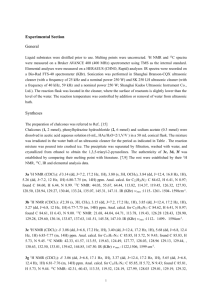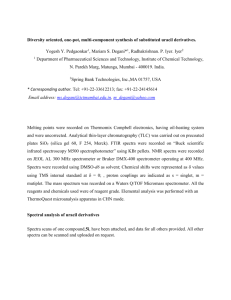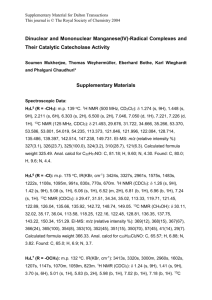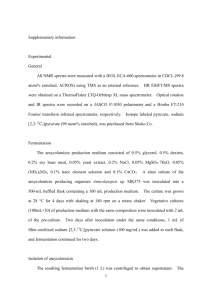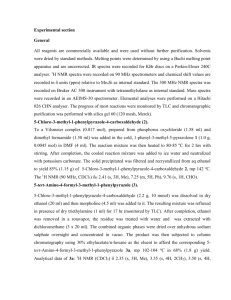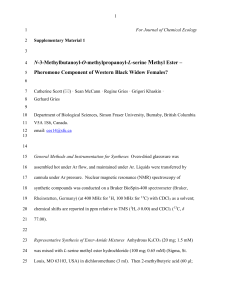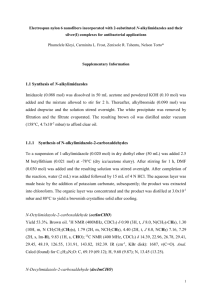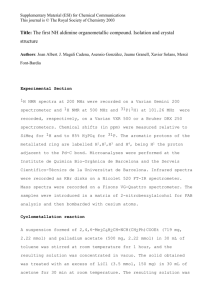POLA_23920_sm_suppinfo
advertisement
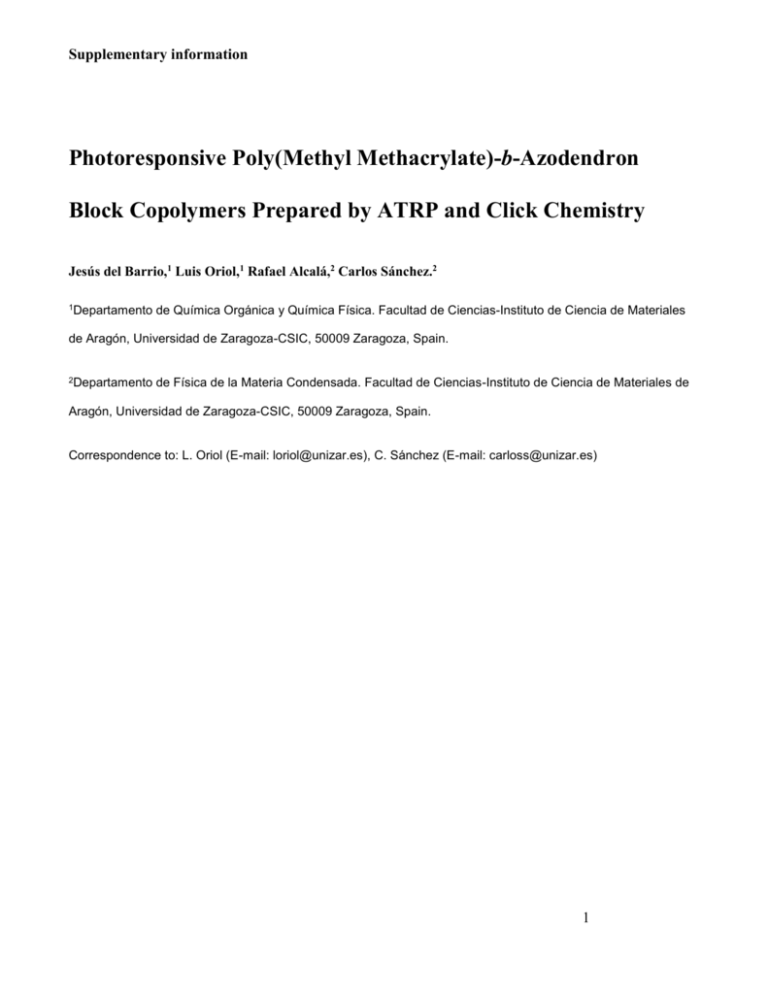
Supplementary information Photoresponsive Poly(Methyl Methacrylate)-b-Azodendron Block Copolymers Prepared by ATRP and Click Chemistry Jesús del Barrio,1 Luis Oriol,1 Rafael Alcalá,2 Carlos Sánchez.2 1Departamento de Química Orgánica y Química Física. Facultad de Ciencias-Instituto de Ciencia de Materiales de Aragón, Universidad de Zaragoza-CSIC, 50009 Zaragoza, Spain. 2Departamento de Física de la Materia Condensada. Facultad de Ciencias-Instituto de Ciencia de Materiales de Aragón, Universidad de Zaragoza-CSIC, 50009 Zaragoza, Spain. Correspondence to: L. Oriol (E-mail: loriol@unizar.es), C. Sánchez (E-mail: carloss@unizar.es) 1 Table of Contents 1. Experimental Section: Synthesis of the Azodendron AZO16b 2. Characterization of Materials 2.1. 1H NMR Spectra of trimethylsilyl (TMS)-protected alkyne-functionalized PMMA 2a and alkyne-functionalized PMMA 3a. 2.2. Characterization data of the synthesized block copolymers 3. Thermal Characterization 3.1. DSC Traces and Textures of the Azodendron AZO16b. 3.2. Textures of the BCs PMMA105-AZO8 and PMMA105-AZO16 2 1. Experimental Section: Synthesis of the Azodendron AZO16b Materials. All starting materials were purchased from Sigma-Aldrich and used without further purification. 6-[4-(4'-Cyanophenylazo)phenyloxy]hexanoic acid was synthesized according to previously described methods.1 The aliphatic polyester dendron bearing a single azide group at the focal point and 16 hydroxyl groups at the periphery (compounds OH16 in Scheme S1) was previously synthesized in our lab.2 Azodendron AZO16b was prepared through an esterification reaction of OH16 with an excess of 6-[4-(4'-Cyanophenylazo)phenyloxy]hexanoic acid using N,N'dicyclohexylcarbodiimide (DCC) as the esterification agent and 4-(dimethylamino)pyridinium ptoluensulfonate (DPTS) as the catalyst (Scheme S1). Scheme S1. Synthesis of the Azodendron AZO16b. OH16 AZO16b OH OH HO HO RO HO O HO O O O RO O O O i. O O O O HO O HO O O O O HO HO HO O O O O RO O RO N3 O O O O O O O O O RO O O O O O O O RO RO N3 O O O O O O HO O O O O O RO O HO O O RO O O O O O O RO HO HO OR OR RO RO HO O O RO RO O NC N N O O 5 :R Conditions: (i) 6-[4-(4’-Cyanophenylazo)phenyloxy]hexanoic acid, N,N’dicyclohexylcarbodiimide (DCC), 4-(Dimethylamino)pyridinium ptoluenesulfonate (DPTS), dichloromethane (CH2Cl2), dimethylformamide (DMF) 3 Synthesis of azodendron AZO16b. DPTS (0.75 g, 2.55 mmol), OH16 (0.29 g, 0.16 mmol) and 6-[4(4'-cyanophenylazo)phenyloxy]hexanoic acid (1.04 g, 3.08 mmol) were dissolved in a mixture of dichloromethane (25 mL) and DMF (6 mL). The reaction flask was flushed with argon and DCC (0.70 g, 3.39 mmol) was added. The mixture was stirred at room temperature (RT) for 72 h under an argon atmosphere. The white precipitate (N,N'-dicyclohexylurea) was filtered off and the solvent was evaporated. The crude product was purified by liquid chromatography on silica gel, eluted with dichloromethane, gradually increasing to 1:40 ethyl acetate:dichloromethane. AZO16b was obtained as an orange powder. Yield: 0.58 g (52 %). 1H NMR (400 MHz, CDCl3, δ): 7.87 (d, J = 8.9 Hz, 64H), 7.74 (d, J = 8.5 Hz, 32H), 6.94 (d, J = 8.9 Hz, 32H), 4.40–4.10 (m, 62H), 3.99 (t, J = 6.5 Hz, 32H), 3.54-3.47 (m, 2H), 2.32 (t, J = 7.6 Hz, 32H), 1.87-1.38 (m, 96H), 1.36–1.15 (m, 45H). 13C NMR (100 MHz, CDCl3, δ): 172.82, 171.96, 171.55, 171.31, 171.25, 162.63, 154.65, 146.69, 133.05, 125.41, 122.98, 118.57, 114.81, 113.15, 68.10, 65.31, 64.97, 64.92, 64.75, 64.30, 49.60, 46.64, 46.41, 46.33, 45.48, 33.98, 29.45, 26.01, 24.84, 17.86, 17.51, 17.42, 17.30. IR (KBr, cm–1): 2225, 2106, 1740, 1601, 1255, 846. MALDI-TOF MS (matrix: dithranol) Calcd. for C381H397N51O78: 6938.52. Found: 6940.5. Anal. Calcd. for C381H397N51O78: C, 65.95; H, 5.77; N, 10.33. Found: C, 65.74; H, 5.76; N, 9.85. Characterization Techniques. Elemental analyses were performed using a Perkin-Elmer 240C microanalyzer. Fourier transform infrared spectroscopy (FT-IR) was performed on a Nicolet Avatar 360-FT-IR spectrophotometer using KBr pellets. 1H nuclear magnetic resonance spectroscopy (NMR) and 13C NMR spectra were measured at RT with a Bruker AV-400 spectrometer at 400 MHz for 1H and at 100 MHz for 13C. Matrix-assisted laser desorption/ionization time-of-flight mass spectrometry (MALDI-TOF MS) was performed on an Autoflex mass spectrometer (Bruker Daltonics). Dithranol was used as a matrix and sodium iodide as a cationic agent matrix. MS data were processed using 4 PolyTools 1.0 (Bruker Daltonics). Mesogenic behavior was evaluated by POM using an Olympus BH-2 polarizing microscope fitted with a Linkam THMS600 hot stage. Thermal transitions were determined by differential scanning calorimetry (DSC) using a TA DSC Q-2000 instrument under a nitrogen atmosphere with powdered samples (about 3 mg) sealed in aluminium pans. Glass transition temperatures were determined at the midpoint of the baseline jump and the mesophase-isotropic phase transition temperature was read at the maximum of the corresponding peaks. 5 2. Characterization of Materials 2.1. 1H NMR Spectra of trimethylsilyl (TMS)-protected alkyne-functionalized PMMA 2a and alkyne-functionalized PMMA 3a. Figure S1. 1H-NMR spectra (400 MHz, CDCl3) of (a) TMS-protected alkyne-functionalized PMMA 2a and (b) alkyne-functionalized PMMA 3a. 6 2.2. Characterization of the synthesized Block Copolymers PMMA206-AZO8. 1H NMR (400 MHz, CDCl3, δ): 7.94–7.85 (m), 7.81–7.71 (m), 7.52 (s), 7.07–6.92 (m), 5.15 (br. s), 4.71–4.60 (m), 4.57–4.49 (m), 4.28–4.11 (m), 4.06–3.97 (m), 3.70–3.49 (br. s), 2.33– 2.24 (m), 2.08–0.68 (m). IR (KBr, cm–1): 2228, 1731, 1602, 1500, 1250, 1146, 842. Anal. Calcd. for C1266H1934BrN27O452: C, 61.20; H, 7.85; N, 1.52. Found: C, 60.75; H, 7.42; N, 1.47. PMMA206-AZO16. 1H NMR (400 MHz, CDCl3, δ): 7.96–7.82 (m), 7.81–7.70 (m), 7.52 (s), 7.04–6.92 (m), 5.15 (br. s), 4.71–4.61 (m), 4.57–4.49 (m), 4.34–4.06 (m), 4.05–3.92 (m), 3.72–3.48 (br. s), 2.32– 2.20 (m), 2.06–0.62 (m). IR (KBr, cm–1): 2228, 1732, 1600, 1580, 1500, 1245, 1149, 847. Anal. Calcd. for C1498H2214BrN51O492: C, 62.28; H, 7.72; N, 2.47. Found: C, 61.61; H, 7.66; N, 2.23. PMMA206-AZO16b. 1H NMR (400 MHz, CDCl3, δ): 7.94–7.80 (m), 7.78–7.67 (m), 7.52 (s), 7.00– 6.85 (m), 5.15 (br. s), 4.69–4.59 (m), 4.57–4.48 (m), 4.38–4.10 (m), 4.03–3.90 (m), 3.74–3.45 (br. s), 2.38–2.20 (m), 2.10–0.63 (m). IR (KBr, cm–1): 2228, 1728, 1600, 1582, 1500, 1251, 1149, 843. Anal. Calcd. for C1418H2054BrN51O492: C, 61.34; H, 7.46; N, 2.57. Found: C, 60.80; H, 7.32; N, 2.20.. PMMA105-AZO8. 1H NMR (400 MHz, CDCl3, δ): 7.93–7.85 (m), 7.81–7.71 (m), 7.51 (s), 7.07–6.92 (m), 5.15 (br. s), 4.71–4.61 (m), 4.57–4.49 (m), 4.29–4.11 (m), 4.06–3.98 (m), 3.70–3.49 (br. s), 2.33– 2.24 (m), 2.08–0.68 (m). IR (KBr, cm–1): 2228, 1727, 1601, 1582, 1500, 1251, 1148, 848. Anal. Calcd. for C761H1126BrN27O250: C, 62.04; H, 7.70; N, 2.57. Found: C, 61.78; H, 7.48; N, 2.78. PMMA105-AZO16. 1H NMR (400 MHz, CDCl3, δ): 7.98–7.82 (m), 7.80–7.69 (m), 7.51 (s), 7.02–6.90 (m), 5.15 (br. s), 4.71–4.60 (m), 4.57–4.49 (m), 4.34–4.06 (m), 4.05–3.92 (m), 3.72–3.48 (br. s), 2.34– 2.20 (m), 2.06–0.67 (m). IR (KBr, cm–1): 2228, 1732, 1600, 1583, 1502, 1252, 1148, 848. Anal. Calcd. for C993H1406BrN51O290: C, 63.51; H, 7.55; N, 3.80. Found: C, 62.70; H, 7.32; N, 3.62. 7 PMMA105-AZO16b. 1H NMR (400 MHz, CDCl3, δ): 7.96–7.80 (m), 7.79–7.67 (m), 7.51 (s), 7.00– 6.85 (m), 5.14 (br. s), 4.69–4.59 (m), 4.57–4.48 (m), 4.38–4.10 (m), 4.03–3.92 (m), 3.71–3.45 (br. s), 2.40–2.25 (m), 2.10–0.63 (m). IR (KBr, cm–1): 2228, 1729, 1600, 1581, 1500, 1250, 1149, 845. Anal. Calcd. for C913H1246BrN51O290: C, 61.34; H, 7.46; N, 2.57. Found: C, 60.83; H, 7.21; N, 2.42. 3. Thermal Characterization 3.1. DSC Traces and Textures of the Azodendron AZO16b. Heat Flow (W/g) 0.4 0.2 0.0 -0.2 -0.4 -0.6 Exo Down -0.8 0 20 40 60 80 100 120 140 160 Temperature (ºC) Figure S2. DSC traces corresponding to the second cooling and heating scans (10 °C/min) of the azodendron AZO16b. 8 Figure S3. POM micrograph of the first cooling scan of AZO16b at 135 °C. 3.2. Textures of the BCs PMMA105-AZO8 and PMMA105-AZO16 (a) (b) Figure S4. POM micrographs of the linear-dendritic BCs PMMA105-AZO16 (a) and PMMA105AZO8 (b) annealed at 115 °C for 12 h. References 1. Mao, G,; Wang, J.; Clingman, S. R.; Ober, C. K.; Chen, J. T.; Thomas, E. L. Macromolecules 1997, 30, 2556. 2. del Barrio, J; Oriol, L.; Sánchez, C.; Alcalá, R. Macromolecules 2009, 42, 5752. 9


